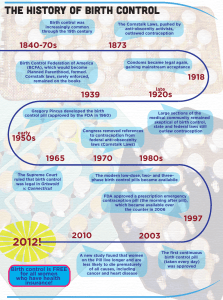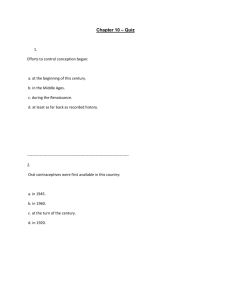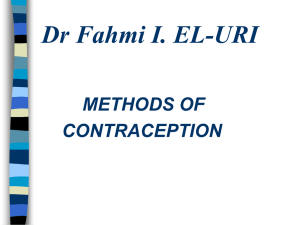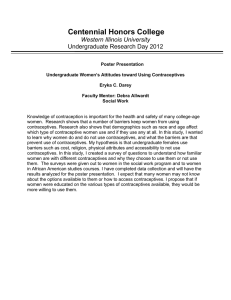Harvard-MIT Division of Health Sciences and Technology HST.071: Human Reproductive Biology
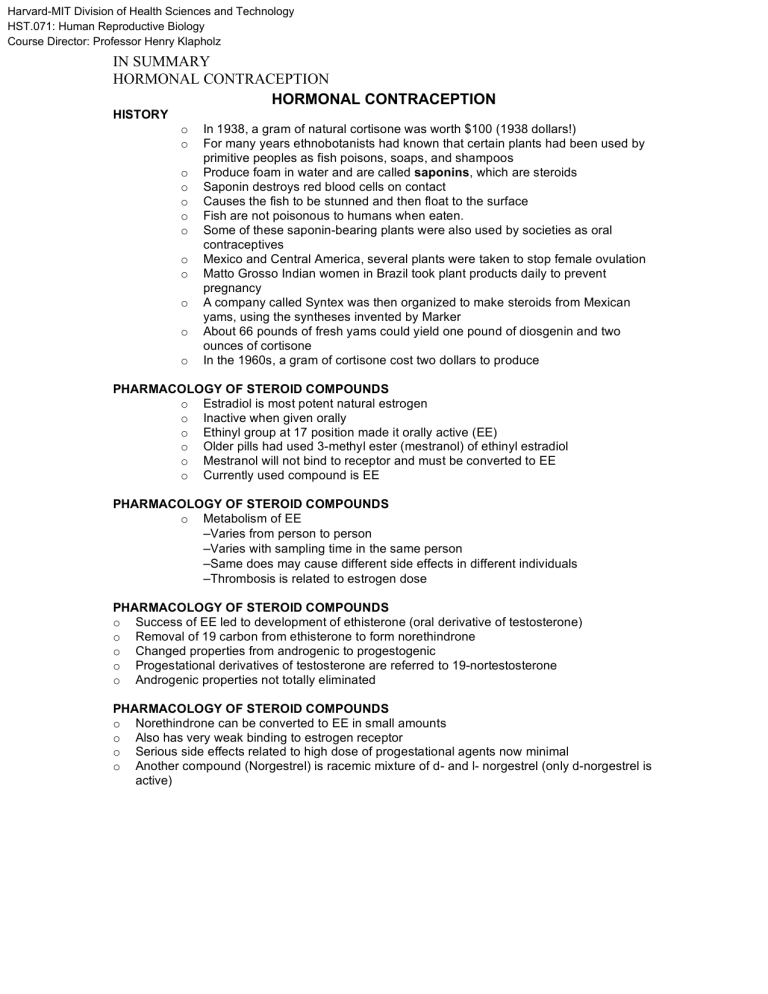
Harvard-MIT Division of Health Sciences and Technology
HST.071: Human Reproductive Biology
Course Director: Professor Henry Klapholz
IN SUMMARY
HORMONAL CONTRACEPTION
HORMONAL CONTRACEPTION
HISTORY o In 1938, a gram of natural cortisone was worth $100 (1938 dollars!) o For many years ethnobotanists had known that certain plants had been used by primitive peoples as fish poisons, soaps, and shampoos o Produce foam in water and are called saponins , which are steroids o Saponin destroys red blood cells on contact o Causes the fish to be stunned and then float to the surface o Fish are not poisonous to humans when eaten. o Some of these saponin-bearing plants were also used by societies as oral contraceptives o Mexico and Central America, several plants were taken to stop female ovulation o Matto Grosso Indian women in Brazil took plant products daily to prevent pregnancy o A company called Syntex was then organized to make steroids from Mexican yams, using the syntheses invented by Marker o About 66 pounds of fresh yams could yield one pound of diosgenin and two ounces of cortisone o In the 1960s, a gram of cortisone cost two dollars to produce
PHARMACOLOGY OF STEROID COMPOUNDS o Estradiol is most potent natural estrogen o Inactive when given orally o Ethinyl group at 17 position made it orally active (EE) o Older pills had used 3-methyl ester (mestranol) of ethinyl estradiol o Mestranol will not bind to receptor and must be converted to EE o Currently used compound is EE
PHARMACOLOGY OF STEROID COMPOUNDS o Metabolism of EE
– Varies from person to person
– Varies with sampling time in the same person
– Same does may cause different side effects in different individuals
– Thrombosis is related to estrogen dose
PHARMACOLOGY OF STEROID COMPOUNDS o Success of EE led to development of ethisterone (oral derivative of testosterone) o Removal of 19 carbon from ethisterone to form norethindrone o Changed properties from androgenic to progestogenic o Progestational derivatives of testosterone are referred to 19-nortestosterone o Androgenic properties not totally eliminated
PHARMACOLOGY OF STEROID COMPOUNDS o Norethindrone can be converted to EE in small amounts o Also has very weak binding to estrogen receptor o Serious side effects related to high dose of progestational agents now minimal o Another compound (Norgestrel) is racemic mixture of d- and l- norgestrel (only d-norgestrel is active)
IN SUMMARY
HORMONAL CONTRACEPTION
Northethindrone Family o Norethindrone o Norethynodrel o Norethindrone acetate o Lynestrenol o Norgestrel o Norgestimate o Desogestrel o Gestodene
Desogestrel & Norgestimate o Two degradative steps before it expresses progestational properties o Active metabolite is 3-keto-desogestrel o Differs from levonogestrel by a methylene group in 11 position o Several metabolites contribute to norgestimate activity o Considered a second generation progestational agent because of metabolite (levonorgestrel)
Definitions of Dose o Low-Dose Oral Contraceptives o Product containing <50 ug EE o First Generation Oral Contraceptives o Products containing 50ug or more EE o Second Generation Oral Contraceptives o Products containing levonorgestrel, norgestimate and other norethidndrone family and 30 or 35 ug EE o Third Generation Oral Contraceptives o Product containing desogestrel or gestodene with 20 or 30 ug EE
Potency o Historically used o Different responses o Uterus o Breast o Liver o Animal and human responses differ o Biologic efficacy of various agents o Clinical characteristics o Efficacy o Side effects o Risks o Benefits is the same
New Progestins o Old belief – androgenic progestins caused heart disease
–
(actually due to coagulation facilitation by estrogen) o New Progestins
–
Desogestrel
–
Gestoden
–
Norgestimate o All are comparable to old products
–
Cycle control, bleeding, amenorrhea o They produce increased SHBG
–
Reduced free testosterone
–
Use for acne and hirsuitism
IN SUMMARY
HORMONAL CONTRACEPTION
Formulations o Attempt to reduce side effects, BTB o No real difference noted over monophasic o 7 day pill free o 4 days pill free o 2 days pill free o Estrophasic approach – low early estrogen
–
Reduced nausea initially
–
As estrogen rises the SHBG rises
–
Reduced androgenic effects
Mechanism of Action o Combined pill is given daily for 3 weeks of 4 o Prevents ovulation
–
Pituitary
–
Hypothalamic o Progestational effect supresses LH (no surge) o Estrogenic effect suppresses FSH (no dominant follicle) o Even if follicle developed there would be sufficient inhibition to prevent ovulation (minipill) o Purpose of the estrogenic component
–
Stability to the endometrium o Prevent irregular shedding (breakthrough bleeding)
–
Potentiates the action of progesterone o Allowed reduction in dose of progestational agents o Probably increases intracellular expression of P receptors o Minimal level of estrogen is required to maintain efficacy of combined pill
–
Effect of progesterone always exceeds that of estrogen o Endometrium (decidualized, exhausted glands) o Cervical mucous (thick and impervious to sperm) o Tubal function (? Reduction in motility – alteration in tubal fluid)
Efficacy of Oral Contraceptives o Most failures occur because of delay in initiation of next cycle o Allow escape ovulation o Use of placebo pills to avoid “forgetting to restart” is a good idea o Most prevalent problem associated with failure o Vomiting o Diarrhea o Use backup method after bout of gastroenteritis
Place pill in vagina o .1% failure rate if motivated, 7.6% during first year
David Wagner - Package Designer
28-day menstrual cycle and would encourage women to view the method as “natural.”
IN SUMMARY
HORMONAL CONTRACEPTION
Benefits of OC o o
Decreased cancer
Ovarian and endometrial cancer risk decreases by 40% after 1 year of total OCP pill use and 80% reduction after 10 years of use o Decreased pelvic inflammatory disease o Decreased rheumatoid arthritis o Regulates and reduces menstrual bleeding o Decreased endometriosis o Decreased osteoporosis o Decreased anemia o Decreased menstrual cramps, ovulation pain & premenstrual tension o Decreased acne and hirsutism o Can adjust menses for vacations or if conditions require amenorrhea o No interference with coitus o Decreased benign ovarian tumors and cysts
FUNDAMENTAL QUESTIONS
1.
How do oral contraceptives work?
2.
Why is estrogen added to combined OC?
3.
Name the common chemical compounds used in modern OC’s?
4.
List the major risks of taking OC’s.
5.
What are the benefits of OC’s other than contraception?
6.
What is the rationale for taking active OC pills for 21 days?
7.
What is the effect of the combined OC on the endometrium?
8.
What is the “morning after pill”?
9.
What is a triphasic OC?
10.To whom would you not prescribe oral contraceptives? Why?
IN SUMMARY
HORMONAL CONTRACEPTION
